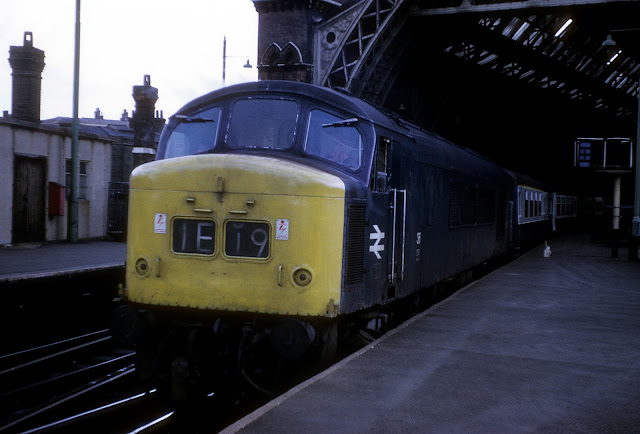In the early 1980s, thousands
were still employed in coal distribution by rail, as well as in all the other
auxiliary industries that depended on it. Many of the lines in the East
Midlands owed their existence to coal traffic, including the nearest to home,
the Mansfield to Southwell link, which was opened by the Midland Railway in 1871.
When we lived in
Mansfield in the mid-1980s, we were within sight of the ex-Midland line to
Nottingham and close to the triangle of lines south west of the Town station,
which was then an impressive old building that had been left in an unimpressive
state of abandonment and disrepair, after local passenger trains had ceased
running in 1964. It has since been refurbished and the passenger service
re-instated.
Mansfield had 3
working pits within its town boundaries, including one at Pleasley [1877-1983],
which was just off this map to the north west of the town centre. The shopping
area had a prosperous bustle to it. During the time that I worked in the town,
all the collieries shown on the map were closed down, most of the services on
the railway lines that connected them were discontinued and the tracks removed.
Class 56 No. 56114
climbs away from Mansfield towards Sutton in Ashfield with empty coal wagons,
in 1986. It is passing the former Mansfield sheds, occupied by other industrial
concerns by that time. The double-header Class 20s and the Class 37s working
this section were displaced by Class 56s on the colliery to power station
traffic during our time there. Locomotives were stabled at Shirebrook depot,
further north on the line to Worksop.
The lines from the triangular
junction south of Mansfield strode across the valley containing the River Maun
and Quarry Lane on viaducts, and served the more recently sunk collieries to
the east of the town. The northern arc of the triangle had provided the link to
Southwell for passenger trains from Mansfield.
Nottinghamshire coal could then get out more easily to the east and south.
Regular passenger services ran between the two towns only until 1929, when they
lost out to a replacement bus service.
Further east from
Mansfield, the map shows the last part of the Central Nottinghamshire coalfield
to be developed. We moved east to Farnsfield, in 1987. The run-down of the coal
industry followed us in the same direction. In 2014, the closure of Thoresby
colliery was announced for the next year, thus ending deep-level coal mining in
the county. Of the lines shown, only the test track using the ex-LD&ECR
through Ollerton still exists at the time of writing. Though there have been
proposals to extend the Mansfield to Worksop, Robin Hood passenger service
eastwards to Ollerton, it has not yet happened.
The former lines to
Bilsthorpe are now public paths. The track bed through Farnsfield to Southwell
has become the Southwell Trail, a well-used amenity for cyclists, walkers,
horse riders and nature lovers. It is managed by Nottinghamshire County Council
and has its own active support group, the Friends of Southwell Trail.
We take full advantage
of this path, which is virtually on our doorstep. Apart from the station houses
and the cuttings, tunnels and bridges, there is little remaining, apart from
this loading gauge at the entrance to the former goods yard, west of the former
Kirklington and Edingley station, photographed in February 2015.
The platform edge with
its rounded blue bricks is clearly visible at the former Kirklington and
Edingley station, looking towards Southwell.
Much of
Nottinghamshire’s coal mining terrain has now been gradually landscaped, with
gradients on the former pit tips levelled off, trees planted, access roads
improved, car parks provided, paths laid, signposts added and information boards
erected to point out aspects of our mining and railway heritage and to point
out bird and butterfly watching possibilities. Subsidence flashes have been transformed
into fishing lakes and wildlife havens.
The old goods shed at
Farnsfield is now a carefully restored private house.
This view was taken looking
along the former track towards Mansfield. The junction with the freight only
line to Bilsthorpe was to the right of the birch trees. Both lines closed
completely in 1964. Bilsthorpe pit remained rail connected from the west until
1997, when the pit ceased production.
[Adapted from an
article appearing in the current edition of the Railway Antiques Gazette, for
which I am grateful to the editor, Tim Petchey.]





















































